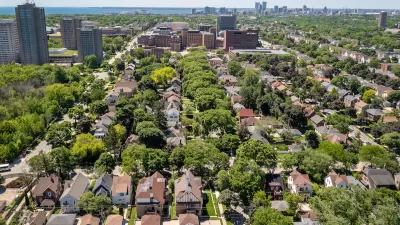The city’s active efforts to keep housing costs down through housing reforms and coordinated efforts among city agencies and developers have kept it one of the most affordable in the nation despite its rapid population growth.

In spite of San Antonio’s rapid growth, the Texas city has managed to keep rent and housing costs more affordable than other U.S. cities, writes Christoper Swope in Governing. “A Redfin Analysis found that middle-income residents in San Antonio can afford 87 percent of the homes listed for sale. Compare that to 10 percent in Las Vegas, 3 percent in Boston, and 0 percent in most of California’s big cities.”
This affordability is due in part to a Housing Policy Task Force started by Mayor Ron Nirenberg in 2017. The task force created a 10-year housing plan that aligned city resources with private-sector actors to develop affordable housing strategies. The city made zoning reforms such as permitting ADUs and offering density bonuses for affordable housing, brought a bond measure to voters that approved $150 million for housing programs, and is experimenting with community land trusts to keep housing costs down. The city also hired a ‘chief housing officer’ focused on coordinating efforts between stakeholders. “That came into play in writing new zoning rules aimed at building affordable housing around bus rapid transit lines planned to open in a few years,” Swope adds.
FULL STORY: Despite Growth, San Antonio’s Holding the Line on Rents

Study: Maui’s Plan to Convert Vacation Rentals to Long-Term Housing Could Cause Nearly $1 Billion Economic Loss
The plan would reduce visitor accommodation by 25,% resulting in 1,900 jobs lost.

North Texas Transit Leaders Tout Benefits of TOD for Growing Region
At a summit focused on transit-oriented development, policymakers discussed how North Texas’ expanded light rail system can serve as a tool for economic growth.

Why Should We Subsidize Public Transportation?
Many public transit agencies face financial stress due to rising costs, declining fare revenue, and declining subsidies. Transit advocates must provide a strong business case for increasing public transit funding.

How to Make US Trains Faster
Changes to boarding platforms and a switch to electric trains could improve U.S. passenger rail service without the added cost of high-speed rail.

Columbia’s Revitalized ‘Loop’ Is a Hub for Local Entrepreneurs
A focus on small businesses is helping a commercial corridor in Columbia, Missouri thrive.

Invasive Insect Threatens Minnesota’s Ash Forests
The Emerald Ash Borer is a rapidly spreading invasive pest threatening Minnesota’s ash trees, and homeowners are encouraged to plant diverse replacement species, avoid moving ash firewood, and monitor for signs of infestation.
Urban Design for Planners 1: Software Tools
This six-course series explores essential urban design concepts using open source software and equips planners with the tools they need to participate fully in the urban design process.
Planning for Universal Design
Learn the tools for implementing Universal Design in planning regulations.
City of Santa Clarita
Ascent Environmental
Institute for Housing and Urban Development Studies (IHS)
City of Grandview
Harvard GSD Executive Education
Toledo-Lucas County Plan Commissions
Salt Lake City
NYU Wagner Graduate School of Public Service





























